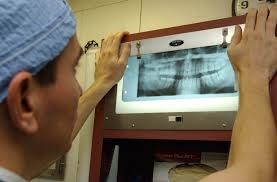 QUESTION: Why does my dentist suggest x-rays?
QUESTION: Why does my dentist suggest x-rays?
ANSWER: X-rays take an image of the bones, the teeth, above the gum line and more importantly, below the gumline. Dental x-rays also reveal the areas between and behind teeth. X-rays can be enlarged to show great detail. With these images, dentists can detect cracks or holes in the enamel, which if left untreated, will allow bacteria to invade the tooth and gum. X-rays also show (in comparison to previous images) any bone loss which is occurring.
QUESTION: How often do I need to be x-rayed?
ANSWER: It depends. We know you hate that answer, but it really is true. Timing of x-rays depends on your personal situation, what your previous oral health history has been, if you are prone to caries (cavities) and/or gum disease, if you have had recent dental work, and if you have other health conditions that could exacerbate dental disease processes, such as diabetes, heart disease or active chemotherapy treatments. Lifestyle choices like smoking also increase the need for more frequent x-rays. Even your age is a consideration.
Most dentists will rightfully insist on new images every 1-3 years with more frequent images if your situation indicates a need.
QUESTION: How safe are dental x-rays?
ANSWER: Pretty safe, but here are some statistics:
Patients are mostly concerned about the amount of radiation that dental x-rays emit.
Radiation of this type is measured in micro-Sieverts. Each x-ray of your teeth on digital or fast-speed film emits about 8 or 9 micro-Sieverts. A panoramic x-ray, which is used to obtain a large image of both the upper and lower jay with a wide lens emits about 24 micro-Sieverts.
So, what can we compare this radiation to?
We are all constantly subject to radiation that comes down to us from outer space, as well as elements in our own earth’s atmosphere that emit radiation. For Michigan residents (since this is a fairly low-lying area), our yearly exposure to this naturally occurring radiation is 3,000- 4,000 micro-Sieverts a year. (Residents of higher altitude regions are subject to higher levels of naturally occurring radiation.)
So, while it is prudent to be concerned with radiation levels of x-rays, your exposure to radiation in the dentist’s chair is a pretty minimal in comparison to the radiation you are regularly exposed to.
If you are concerned with any aspect of dental x-rays, we urge you to talk to your oral health care team.